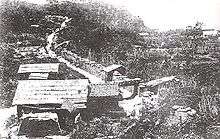Battle of Shiroyama
| Battle of Shiroyama 城山の戦い | |||||||
|---|---|---|---|---|---|---|---|
| Part of the Satsuma rebellion | |||||||
 Japanese depiction of the Battle of Shiroyama. Saigō Takamori can be seen in red and black uniform directing his troops in the upper right corner. | |||||||
| |||||||
| Belligerents | |||||||
| Imperial Japanese Army | Samurai of Satsuma | ||||||
| Commanders and leaders | |||||||
| Yamagata Aritomo | Saigō Takamori † | ||||||
| Strength | |||||||
| 30,000 troops[1] | About 350 to 500 samurai | ||||||
| Casualties and losses | |||||||
| 30[2] | All | ||||||
The Battle of Shiroyama (城山の戦い Shiroyama no tatakai) took place on 24 September 1877, in Kagoshima, Japan.[3] It was the final battle of the Satsuma Rebellion, where the heavily outnumbered samurai under Saigō Takamori made their last stand against Imperial Japanese Army troops under the command of Generals Yamagata Aritomo and Kawamura Sumiyoshi. The battle culminated in the annihilation of Saigō's army as well as his death, marking the end of the Satsuma Rebellion.
Battle
Following defeat at the Siege of Kumamoto Castle and in other battles in central Kyūshū, the surviving remnants of the samurai forces loyal to Saigō Takamori fled back to Satsuma, seizing the hill of Shiroyama overlooking Kagoshima on 1 September 1877.
Imperial army troops under the command of General Yamagata Aritomo and marines under the command of Admiral Kawamura Sumiyoshi began arriving soon after, and the rebels were surrounded. After combat losses and defections, Saigō had only about 500 samurai remaining of a force of over 20,000 which had besieged the government garrison in the city of Kumamoto only six weeks earlier.
With 30,000 troops,[1] Yamagata, although greatly outnumbering Saigō, bided his time constructing a series of fortifications to encircle Saigō and preempt any chance of a breakout, additionally requisitioning five warships to bombard the rebels and reduce their defenses. He was planning an attack from all sides, and in an effort to prevent another escape, ordered that any position engaged by the enemy was to be fired upon, regardless of friendly casualties.[3] Saigō defended his position with limited musket support and a few pieces of artillery, melting down metal statues to produce bullets and tending to injuries with a carpenter's saw.[3]

After firing a final barrage of artillery lasting the night, Yamagata's men attacked Saigō's position. The samurai, under heavy fire, charged the lines of the imperial army, which had not been trained for close-quarter sword fighting. In just a few minutes, the once organized line turned into disarray. Highly skilled samurai swordsmanship prevailed against an army with very little traditional training. For a short time, Saigō's lines held, but was forced back due to weight of numbers.
Saigō was mortally wounded in the femoral artery and stomach, and was carried by Beppu Shinsuke downhill to find a place to end his life. Serving as kaishakunin, Beppu cut off Saigō's head and hid it to prevent it from being found by the enemy.[3] After Saigō's death, Beppu and the last of the "ex-samurai" drew their swords and plunged downhill toward the Imperial positions and to their deaths. With these deaths, the Satsuma rebellion came to an end.
Aftermath
On 22 February 1889, Emperor Meiji pardoned Saigō posthumously.[4] Statues in Ueno Park, Tokyo and near the ruins of Kagoshima Castle stand in his memory.
See also
References
- 1 2 Hickman, Kennedy. "Battle of Shiroyama – Satsuma Rebellion Battle of Shiroyama". about.com: Military History. Retrieved 2010-09-24.
- ↑ Mounsley, Augustus H. (1879). Satsuma Rebellion: An Episode of Modern Japanese History. University Publications of America. ISBN 0-89093-259-X.
- 1 2 3 4 "Satsuma Rebellion: Satsuma Clan Samurai Against the Imperial Japanese Army". Military History Magazine. 12 June 2006.
- ↑ Perkins, Dorothy. Japan Goes to War: A Chronology of Japanese Military Expansion. Diane Publishing.
5. Sabaton: Shiroyama. NuclearBlast Records
Further reading
- Keane, Donald (2005). Emperor Of Japan: Meiji And His World, 1852–1912. Columbia University Press. ISBN 0-231-12341-8.
- Mounsley, Augustus H. (1879). Satsuma Rebellion: An Episode of Modern Japanese History. University Publications of America. ISBN 0-89093-259-X.
- Ravina, Mark (2004). The Last Samurai: The Life and Battles of Saigō Takamori. Wiley. ISBN 0-471-08970-2.
Coordinates: 31°36′00″N 130°33′00″E / 31.6000°N 130.5500°E